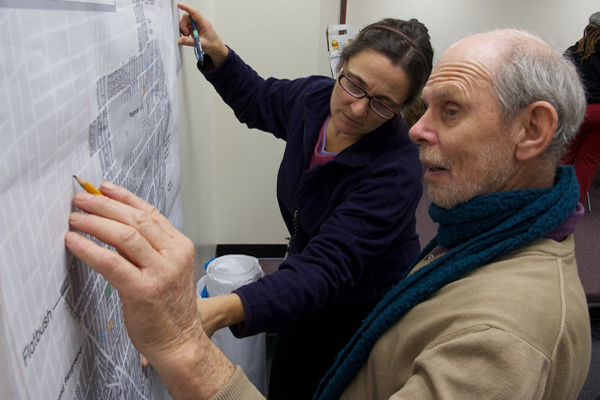
Photo by: Colin Weatherby
Michael Carder & Susannah Laskaris identify park space on a map at a recent participatory budgeting meeting in Brooklyn’s 45th Council district, one of four where a pilot project is under way to allow constituents to decide how some capital funding is spent.
Residents of four City Council districts will soon vote on how to spend municipal funds that will pay for expenditures in their communities, like planting trees and installing security lights. City councilmembers in these districts pledged at least $1 million each to the projects their constituents select during a new pilot program called participatory budgeting, a first for New York City.
The money comes from the city’s capital budget, which differs from the annual operating budget that funds day-to-day expenses. The capital budget covers physical public improvements that cost $35,000 or more. Capital funds are disbursed through councilmembers’ discretionary budget, the money the speaker of the City Council allocates to all councilmembers to spend as they see fit in their district. The amount councilmembers receive in capital funds varies, but can be $4 to $5 million.
Participatory budgeting originated in Brazil, but the New York City project is the brainchild of Josh Lerner, co-director of the nonprofit Participatory Budget Project. Lerner brought the idea to politicians and community leaders in 2010. Four City councilmembers—Brooklyn Democrats Brad Lander and Jumaane D. Williams, Manhattan Democrat Melissa Mark–Viverito and Queens Republican Eric Ulrich—agreed to participate.
Goal is increased engagement
The primary goal of participatory budgeting is to get residents more involved in government. The Participatory Budget Project has been working with lawmakers and communities in Toronto for 10 years. It launched a project in Chicago’s 49th Ward in 2009. Lerner said these initiatives produced better educated and more politically empowered citizens.
“It’s a huge learning process,” says Lerner. “People who before did not know how city government worked became city government experts.”
Participatory budgeting in New York began in October. Committees of neighborhood leaders and residents organized community meetings in order to brainstorm building projects and educate community members about capital funding.
At the end of that stage, residents who wanted to take an active role volunteered as budget delegates. These delegates began a weeks-long process of taking the projects from ideas scrawled on poster board to fully developed proposals on neighborhood ballots. Delegates divided themselves into committees to tackle areas such as parks and recreation, education and public art.
Since November, budget delegates have whittled down the ideas that came out of community meetings, considering only those that meet the city’s criteria for capital funding. They met with experts from city agencies, community organizations and nonprofits to flesh out projects and set budgets.
The budget delegates sent their final list of projects to city agencies for review. They’ll present the approved projects to their communities through the middle of March.
Some seek expansion
Some budget delegates say they hope the participatory budget model could be expanded to pay for services such as after-school programs and electronic waste pickup.
“Services are huge and services are needed,” says Rachel Fine, a budget delegate on the public health, safety and sanitation committee in District 39. “When we were told that it could only be for capital projects and not services, people were still submitting ideas for service projects.”
The money for these services comes primarily from a councilmember’s expense budget, a separate stream of discretionary funds. This money is generally spent on renewing funding for nonprofit organizations.
Lander, who represents eight neighborhoods stretching from Cobble Hill to Kensington, worries that allocating funding for services through the participatory budget process could amount to taking money from a little league to fund a senior center.
“You don’t want to make it like a reality show between nonprofit organizations,” says Lander.
District voters will go to the ballots in March to vote on the proposals. After that, City Council must approve the projects. But Williams, who represents Flatbush, Farragut and Flatbush, says funding every project wasn’t the only measure of success.
“The main thing is not the vote. The main thing is the community engagement,” Williams says.







